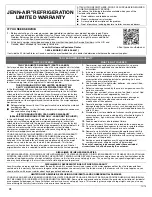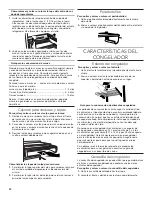
19
PERFORMANCE DATA SHEETS
Water Filtration System
Model P1WB2/P1RFWB2 Capacity 200 Gallons (757 Liters)
Model P1WB2L/P1RFWB2L Capacity 200 Gallons (757 Liters)
System tested and certified by NSF International against NSF/ANSI
Standard 42, Standard 53, and Standard 401 for the reduction of
contaminants specified on the Performance Data Sheet.
This system has been tested according to NSF/ANSI Standards 42, 53 and 401 for the reduction of the substances listed below.
The concentration of the indicated substances in water entering the system was reduced to a concentration less than or equal to the permissible
limit for water leaving the system, as specified in NSF/ANSI Standards 42, 53, and 401.
Substance Reduction
Aesthetic Effects
Influent Challenge Concentration Maximum Permissible
Product Water Concentration
Average % Reduction
Chlorine Taste/Odor
2.0 mg/L ± 10%
≥50% reduction
>97.5%
Particulate Class I*
At least 10,000 particles/mL
≥85% reduction
99.2%
Contaminant Reduction
Influent Challenge Concentration Maximum Permissable
Product Water Concentration
Average %
Reduction
Lead***: @ pH 6.5 / @ pH 8.5
0.150 mg/L ± 10%
0.010 mg/L
>99.3% / >99.3%
Mercury: @ pH 6.5 / @ pH 8.5
0.006 mg/L ± 10%
0.002 mg/L
>96.4% / 90.8%
Asbestos
10
7
to 10
8
fibers/L
††
99%
99%
Cysts
†
50,000/L min.
99.95%
>99.99%
Turbidity
11 NTU ± 10%
0.5 NTU
>99.1%
Alchor
0.040 mg/L ± 10%
0.002 mg/L
97.6%
Atrazine
0.009 mg/L ± 10%
0.003 mg/L
94.5%
Benzene
0.015 mg/L ± 10%
0.005 mg/L
96.6%
Carbofuran
0.080 mg/L ± 10%
0.040 mg/L
91.1%
Chlorobenzene
2.000 mg/L ± 10%
0.100 mg/L
99%
Endrin
0.006 mg/L ± 10%
0.002 mg/L
96.6%
Ethylbenzene
2.100 mg/L ± 10%
0.700 mg/L
99.9%
Lindane
0.002 mg/L ± 10%
0.0002 mg/L
99%
MTBE
MTBE 0.015 mg/L ± 10%
0.005 mg/L
90.6%
O-Dichlorobenzene
1.800 mg/L ± 10%
0.600 mg/L
99.9%
Tetrachloroethylene
0.015 mg/L ± 10%
0.005 mg/L
96.4%
Toxaphene
0.015 mg/L ± 10%
0.003 mg/L
>93.7%
TTHM
0.045 mg/L ± 10%
0.080 mg/L
99.5%
Styrene
2.000 mg/L ± 10%
0.100 mg/L
99.9%
VOC
0.300 mg/L ± 10%
0.015 mg/L
99.7%
Atenolol
200 ± 20%
30 ng/L
95.7%
Trimethoprim
140 ± 20%
20 ng/L
96.1%
Linuron
140 ± 20%
20 ng/L
96.3%
Estrone
140 ± 20%
20 ng/L
90.6%
Nonylphenol
1400 ± 20%
200 ng/L
93.7%
■
It is important that operational, maintenance, and filter replacement
requirements be carried out for the product to perform as
advertised. Property damage can occur if all instructions are not
followed.
■
The disposable cartridge must be changed at least every 6 months.
■
Use replacement filter P1RFWB2L, Part #EDR3RXD1/EDR3RXD1B.
2015 suggested retail price of $49.99 U.S.A./$54.95 Canada.
Prices are subject to change without notice.
■
The filter monitor system measures the amount of water that
passes through the filter and alerts you when it is time to replace
the filter. To learn how to check the water filter status, see “Using
the Controls” or “Water Filtration System” in the User Instructions
or User Guide.
■
After changing the water filter, flush the water system. See “Water
and Ice Dispensers” or “Water Dispenser” in the User Instructions
or User Guide.
■
These contaminants are not necessarily in your water supply. While
testing was performed under standard laboratory conditions, actual
performance may vary.
■
The product is for cold water use only.
Application Guidelines/Water Supply Parameters
Water Supply
Potable City or Well
Water Pressure
30 - 120 psi (207 - 827 kPa)
Water Temperature
33° - 100°F (0.6° - 37.8° C)
Service Flow Rate
0.5 GPM (1.89 L/min.) @ 60 psi.
* Class I particle size: >0.5 to <1 um
*** Compliant for Lead reduction requirements under NSF/ANSI Standard 53 as tested by Pace Analytical Services, Inc.
†
Based on the use of Cryptosporidium parvum oocysts
††
Test requirement is at least 100,000 particles/mL of AC Fine Test Dust
® NSF is a registered trademark of NSF International.
Test Parameters: pH = 7.5 ± 0.5 unless otherwise noted. Flow = 0.5 gpm (1.89 Lpm). Pressure = 60 psig (413.7 kPa).
Temp. = 68°F to 71.6°F (20°C to 22°C). Rated service capacity = 200 gallons (757 liters).
The compounds certified under NSF 401 have been deemed as “emerging compounds/incidental contaminants.” Emerging compounds/incidental
contaminants are those compounds that have been detected in drinking water supplies at trace levels. While occurring at only trace levels, these
compounds can affect the public acceptance/perception of drinking water quality.
■
The water system must be installed in compliance with state and
local laws and regulations.
■
Do not use with water that is microbiologically unsafe or of
unknown quality without adequate disinfection before or after
the system. Systems certified for cyst reduction may be used on
disinfected waters that may contain filterable cysts. EPA Est. No.
082047-TWN-001
■
Refer to the “Warranty” section (in the User Instructions or User
Guide) for the Manufacturer’s limited warranty, name and telephone
number.
















































